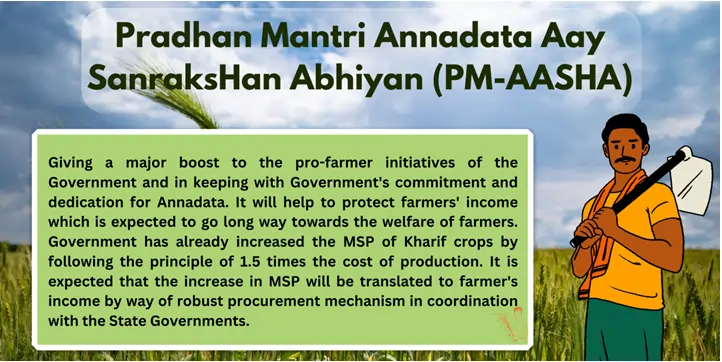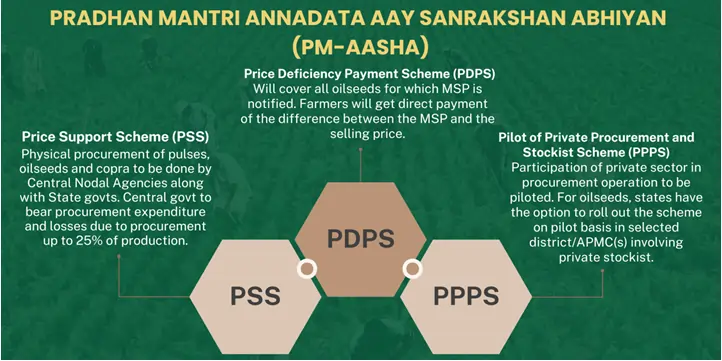
Under the PM-AASHA scheme, the Union Cabinet led by Shri Narendra Modi has approved the continuation of the projects for farmers so that they get remunerative prices as well as for the protection and stabilisation of vital commodities prices for the consumers.. At the national level the Government of India has merged the Price Support Scheme (PSS) and the Price Stabilization Fund (PSF) of PM AASHA so that effectiveness for farmers and consumers could be improved. The PM-AASHA Integrated scheme will improve the effective implementation by identifying remunerative prices to producers and addressing the issues of the prone price fluctuation involving the availability of crucial foods at reasonable prices to consumers. The AEIMS will now consist of the features of PM-AASHA such as, Price Support Scheme (PSS), Price Stabilization Fund (PSF), Price Deficit Payment Scheme (POPS), and Market Intervention Scheme (MIS).
The purchases of the specifically nominated pulses, oilseeds & copra will start with 25% of the national production of the said identified crops from SY 2024-25 under the Price Support Scheme under MSP. This will also enable states to directly procure larger volumes of these crops from framers at MSP so that the farmers do not resort to distress sales at sub economic prices.
Pradhan Mantri Annadata Aay SanraksHan Abhiyan (PM-AASHA)
PM-AASHA, is an integrated promotional and protectionist umbrella scheme which seeks to guarantee remunerative price for the agricultural produce of the farmers and at the same time protect the consumers from high and fluctuating prices of agricultural commodities.
Background and Objectives
- Minimum Support Price (MSP): At the core of PM-AASHA, there is auction of creating minimum price guarantee for farmers, which they want for their produce. This makes sure that they get the best reward as regards their efforts they have put in their work.
- Price Support Scheme (PSS): Under PM-AASHA the government makes the facility of procurement of certain crops such as pulses, oil seeds, copra etc. at MSP. This in particular does not allow farmers to make distress sales.
- Price Stabilization Fund (PSF): The scheme also keeps an adequate safety stock of some products, such as pulses and onions to dampen high flutters on prices to consumers.
Components of PM-AASHA
- Price Support Scheme (PSS): It buys notified pulses oilseeds and copra at a predetermined MSP that is the minimum support price. From the 2024-25 seasons, this procurement will be restricted to 25 per cent of the national production of these crops.
- Price Deficit Payment Scheme (PDPS): This scheme pays the farmers the minimum price they will receive for their produce as declared by the government, in the event that the market price goes below this level.
- Pilot to Private Procurement and Stockist Scheme (PPPS): Currently there is a pilot program whereby private players have been introduced to participate in procurement and storage.

Enhancements and Renewals
- Government Guarantee: Facility of guarantee for procurement of notified pulses, oilseeds and copra at Minimum Support Price has been continued and the assured amount of guarantee has been increased to Rs, 45000 crore.
- Tur, Urad & Masur: As for the procurement that has been initially set at 25 percent for tur, urad and masur for 2024-25 season, there will be 100 percent procurement exempting the ceiling.
Benefits of Pradhan Mantri Annadata Aay SanraksHan Abhiyan (PM-AASHA)
It is an extensive program that focused on the improvement of farmers’ conditions and the provision of stability to the rates of essential products.it has the following benefits:
Price: It aims to provide an better price to the farmers. It also focuses on reducing the differences between market prices and MSP so as to strengthen the procurement process. This will guarantee that farmers are paid an improved wage for services offered hence increasing agriculture production.
Integration of Schemes: PM-AASHA has been formed by merging Price Support Scheme (PSS) and Price Stabilization Fund (PSF) by the government. This integration actually enhances operations of the system which in turn enhances its efficiency. It also helps in that some of the essential commodities get to the hands of the consumer at affordable prices.The components of PM-AASHA include:
- Price Support Scheme (PSS): Purchasing of notified pulses, oil seeds and copra at the MSP. The ceiling for procurement differs from crop to crop; however, its general idea is to eliminate distress selling from farmers.
- Price Stabilization Fund (PSF): To sustain the pulse and onions, the government has had to manage strategic buffer stocks in an effort to keep prices of the staples down and curb cases of hoarding.
- Price Deficit Payment Scheme (POPS): Buying the farmer’s produce at MSP or even giving him direct payment each time market prices go down.
- Market Intervention Scheme (MIS): Regulating markets in a bid to try and keep prices at certain levels when there is a change.
Boosting Rural Economy
PM-AASHA makes the effort in the revival of the rural economy. Thus through giving better income to the farmers it was encouraging them to explore more on crop production. It also enhances the balance of crops that may be required in fields thus allowing for the sustainability of soil and water sources.
Enhanced Government Guarantee
Government has renewed and enhanced the existing Government guarantee for Rs.45,000 crore for purchase of notified pulses, oilseeds and copra at MSP. This step also encourages sourcing of products from farmers and thereby cuts on importation and encourages production locally.
Stable Food Prices for Consumers
It goes without saying that thanks to PM-AASHA the issue of unstable food prices is no longer a dream. Basically the scheme ensures that through presence of buffer stocks and interventions, there is check on extreme price oscillations of agri-horticultural commodities. Consumers are able to afford the goods at cheap prices while at the same time protecting the interest of the farmers.
Challenges Faced by PM-AASHA
Procurement Infrastructure
Generally, it is postulated that the PM-AASHA scheme seeks to help in the procurement process leading to fair prices to the farmers. But poor infrastructure is still an issue that tends to provide it a sore. The lacuna of this institutional support was highlighted as early as in a 2016 report by NITI Aayog and, regrettably, still, PM-AASHA measures have not effectively filled.For the government to empower our farmers adequately, other areas which need attention include proper storage facilities, transport systems and appropriate market channels.
Distribution System
There is a huge stock of pulses and oilseeds for which the National Agricultural Cooperative Marketing Federation of India has a commanding position. However, the distribution policies of the crops are inefficient thus reducing the impact of its use.We require well-coordinated distribution networks so that the production reaches various places on time.
Price Manipulation
It is said that traders especially those in the rural areas, often engage in a game which involves price control. This can leave farmers short changed.The government should continue monitoring the market conditions, acting in a way that there is increased transparency, and provide harsh penalties for ‘unfair competitions.’ But, then again our farmers should not be subjected to these closures and they deserve a better deal.
Private Procurement Challenges
It has its challenges for the pilot of the Private Procurement & Stockist Scheme (PPPS). Overtime, non-remunerative payments required when wheat and paddy are procured from the private companies have been a problem.May be, they could problematize the reimbursement process and try to ensure that the payment has been effected in good time to motivate more players in the private sector.
Funding Constraints
The organization which has been entrusted with the responsibility of implementing the PM-AASHA has been hit by poor prices in the market. These are the reasons that affect the success of the scheme.Depending on the project, the funds needed can be a lot, and the government might need to fund it further or look for other ways of financing the initiative to keep it running.
Way Forward
Strengthen Procurement Infrastructure
Government should therefore invest in modern storage facilities, cold chains and proper transportation networks. It is now little wonder then that it is time to put a strong base for our agricultural ventures.Integrate private actors to work on the efficiency of the distribution and transportation networks so as to minimize the loss on the way.
Revamp Distribution Channels
Simplify the distribution process. Make sure that the surplus produce gets to the markets as efficiently as possible.Technology – maybe an app that is friendly for the farmers; IT’s that will directly link them with the buyers or the cooperatives.
Market Intelligence and Transparency
Establish a system that will help check on the prices and prevent inflation. Real-time data can help a farmer / a farming business.MSP information should reach farmers; teach the farmers about the workings of the market. Knowledge is power.
Encourage Private Participation
Therefore, it is necessary to address the issues on reimbursement delays that are being faced by private companies. Don’t make it a strenuous and unappealing affair. Therefore, promote private players who should buy crops at MSP during volatilities of the market.
Sustainable Funding
Explore innovative financing models. Public-private partnership is another similar mode of sourcing for funds, it can assist in reducing this gap. Make increased and better spending on agriculture in budgets by the government- after all they give us our food and feed our nation.
What is ‘Minimum Support Price’?
The Minimum Support Price (MSP) is now a lifeline to our hardworking farmers which provide basic financial security. Another way, it is possible to consider it as the firm ground that provides support over the turbulent stream of market changes.
- What Is It? : The MSP is the minimum reference price fixed by the Government of India for agri-produce – food grains produced during the monsoon and winter seasons known as kharif and Rabi respectively. These are the crops that one must hat tip (or give some kind of subtle sign of appreciation to) since they have a lot to do with our food basket.
- Why Does It Exist? : Well, the MSP is not something that has been conjured out of thin air, it has a very real definition. It is well planned so that growers of the crops get an appropriate price for the produce that has been grown.
- How Does It Work? : When the government agencies (let’s picture them as crop-buying superheroes) purchase these crops, then they offer the MSP. And that means it is not some abstract thing – it is the price at which the government really purchases grains from our gardening buddies i.e. our farmers.
- Who decides it? : MSP is decided by the commission for agriculture costs and prices.